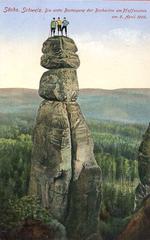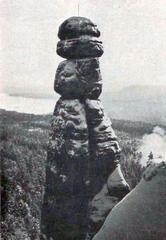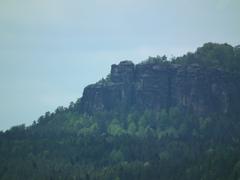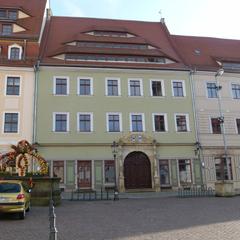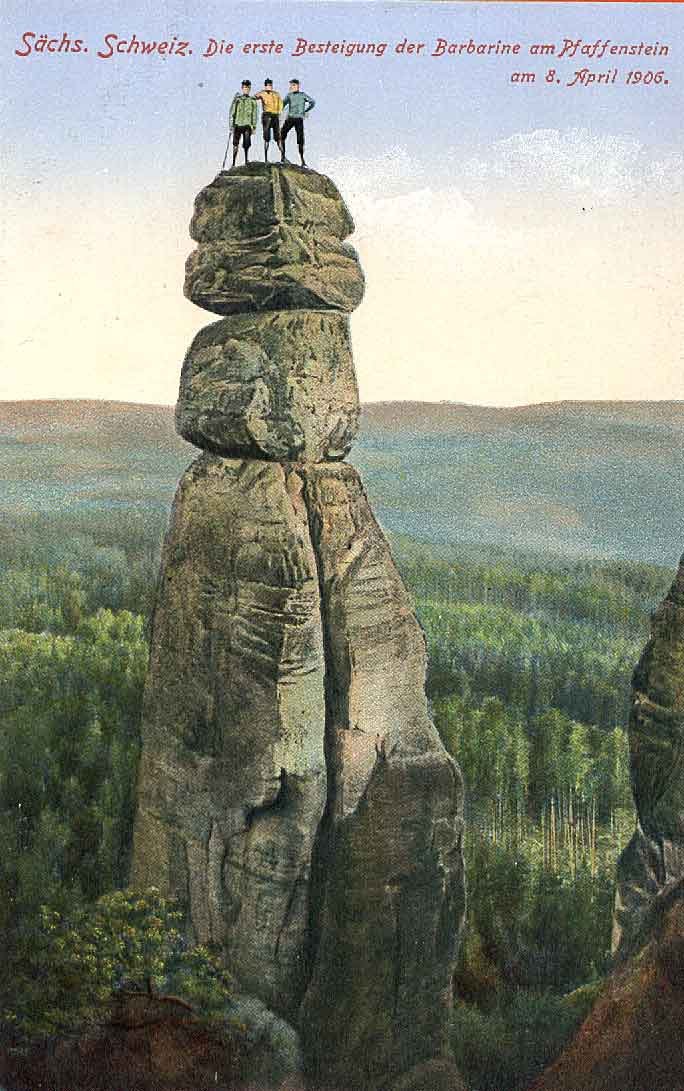
Guide to Visiting Barbarine in Pirna, Germany
Date: 24/07/2024
Introduction
Barbarine, an iconic rock formation in the German part of the Elbe Sandstone Mountains, is renowned for its stunning natural beauty and significant cultural heritage. Located within the Pfaffenstein massif near the village of Pfaffendorf, this 42.7-meter-high pinnacle stands as a symbol of Saxon Switzerland. With a history that dates back to the Late Tertiary period, Barbarine’s unique geological formation has captivated visitors and geologists alike (Wikipedia). The rock’s historical significance is further accentuated by its early 20th-century climbing milestones and the enchanting local legends that surround it. Today, Barbarine draws thousands of hikers, nature enthusiasts, and cultural tourists who seek to explore its scenic trails and nearby attractions in Königstein and Pirna. This guide aims to provide a comprehensive overview of Barbarine, including its history, visitor information, travel tips, and environmental preservation efforts, ensuring that your visit is both enriching and memorable.
Table of Contents
- Introduction
- History and Significance
- Visitor Information
- Nearby Attractions
- Environmental and Preservation Efforts
- Frequently Asked Questions (FAQ)
- Conclusion
History and Significance
Origins and Geological Formation
The formation of Barbarine is attributed to geological processes that shaped the Elbe Sandstone Mountains during the Late Tertiary period. The uplifting of the Ore Mountains and lateral pressure from the Lusatian Highlands caused the sandstone plate to fracture along intersecting lines. This, combined with the increasing stream velocity of the Elbe River and regressive erosion in its side valleys, led to the creation of isolated rock pinnacles like Barbarine.
Historical Climbing Milestones
Barbarine has a rich history of climbing, with the first documented ascent occurring on September 19, 1905, by climber Felix Wendschuh. This initial climb marked the beginning of Barbarine’s significance as a climbing destination. However, to preserve the structure, climbing was banned in 1975, and reinforcement efforts were undertaken in 1979/80 to stabilize the summit blocks with sandstone and artificial materials.
Legends and Cultural Significance
According to local legend, Barbarine is a petrified virgin, serving as a perpetual memorial of punishment. The tale narrates that a mother instructed her daughter to attend church on a Sunday, but the daughter instead went to pick bilberries on the Pfaffenstein. In a fit of anger, the mother cursed her daughter, turning her to stone on the spot. This folklore has been passed down through generations, adding to the cultural significance of Barbarine.
Visitor Information
Visiting Hours
Barbarine is accessible throughout the year, but climbing is restricted to preserve the formation. Visitors can explore the surrounding Pfaffenstein massif and enjoy scenic viewpoints and hiking trails.
Ticket Prices
There is no specific ticket required to visit Barbarine or the Pfaffenstein massif. However, some amenities and guided tours in the area may have associated costs.
Travel Tips
- Best Time to Visit: Spring and autumn offer the best weather for hiking and exploring the area.
- Hiking Trails: Popular trails include the Nadelöhr and Klammweg, which provide access to scenic viewpoints and other rock formations.
- What to Bring: Comfortable hiking shoes, water, and a camera for capturing the stunning landscapes.
Nearby Attractions
Pfaffenstein Massif
Barbarine is part of the larger Pfaffenstein massif, a notable climbing area in Saxon Switzerland. The massif comprises 32 rocks and has been a popular climbing destination since the early 20th century. The highest point is the 349.6-meter-high (1,147 feet) Quirl, another table hill in the region.
Other Attractions in Königstein
- Königstein Fortress: One of the largest hilltop fortifications in Europe, offering panoramic views and historical exhibits.
- Bastei Bridge: A famous rock formation with a stone bridge offering breathtaking views of the Elbe Sandstone Mountains.
- Elbe River Cruises: Scenic boat trips along the Elbe River, providing a unique perspective of the landscape.
Environmental and Preservation Efforts
Due to its geological and cultural importance, significant efforts have been made to preserve Barbarine. The rock pinnacle has suffered from erosion, exacerbated by a lightning strike in 1944. To mitigate further damage, the summit blocks were reinforced with sandstone and treated with water-repellent chemicals in the late 1970s. Today, climbing is restricted, with access primarily granted to geologists and scientists working to prevent further erosion.
Conclusion
Barbarine stands as a testament to the natural and cultural heritage of Saxon Switzerland. Its geological formation, historical climbing milestones, and rich folklore make it a significant landmark in the region. Preservation efforts continue to protect this iconic rock pinnacle, ensuring that future generations can appreciate its beauty and historical importance. Visitors to the Pfaffenstein massif can enjoy a range of outdoor activities while respecting the environmental measures in place to safeguard Barbarine.
Frequently Asked Questions (FAQ)
What are the visiting hours for Barbarine? Barbarine is accessible year-round; however, climbing is restricted.
How can I get tickets to visit Barbarine? There is no specific ticket required to visit Barbarine. Some amenities and guided tours in the area may have associated costs.
What are the best trails to hike around Barbarine? Popular trails include the Nadelöhr and Klammweg, offering access to scenic viewpoints and other rock formations.
References
- Wikipedia. (n.d.). Pirna. Retrieved from Wikipedia
- Sächsische Dampfschiffahrt. (n.d.). Pirna - Gateway to Saxon Switzerland. Retrieved from Sächsische Dampfschiffahrt
- Travellers Worldwide. (n.d.). Best Places to Visit in Germany. Retrieved from Travellers Worldwide
- Just Ask Layla. (n.d.). Itinerary - 7 Days Wandern, Radfahren, Kajaktour Sächsische Schweiz. Retrieved from Just Ask Layla
- Sculpture Network. (2024). Pirna Sculpture Summer 2024. Retrieved from Sculpture Network
- MyGermanCity. (n.d.). Pirna. Retrieved from MyGermanCity
- Infoglobe. (n.d.). Germany: Saxon Switzerland – Pfaffenstein and Barbarine. Retrieved from Infoglobe
